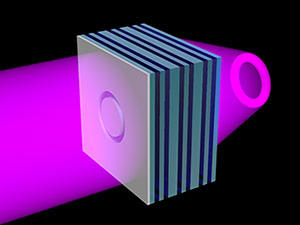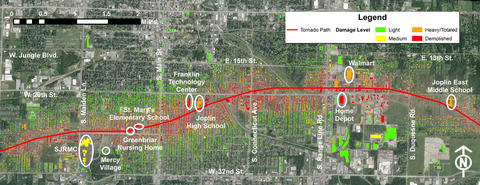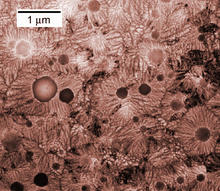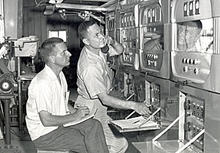Milestones on the way to quantum computing. A landmark study of how communities can better prepare for tornadoes. Publication of a draft cybersecurity framework for the nation. Evidence of a potentially new class of solids. New programs to promote and support innovation in manufacturing.
These are a few of the many and varied accomplishments and contributions arising from the National Institute of Standards and Technology (NIST) in 2013.
Over the past year, NIST also contributed its measurement expertise and technology know-how to detecting chemical agents and hidden explosives; building new forensic science labs; storing nuclear waste; standardizing energy-usage information in a consumer-friendly format; devising a new, compact type of portable atomic clock; developing image-quality standards for luggage-screening systems used in airports; and even helping a promising new malaria vaccine advance in clinical trials.

New partnerships also were forged in 2013. Fifteen major companies formally established partnerships with the NIST-hosted National Cybersecurity Center of Excellence. NIST joined with the National Telecommunications and Information Administration to initiate a national Center for Advanced Communications, devoted to furthering U.S. leadership in wireless broadband technologies. And it piloted its first DNA reference materials in support of the young Genome in a Bottle Consortium, a NIST-led collaboration working on measurement tools to ensure the accuracy gene-sequencing analyses.
Chosen to convey the diversity of NIST's measurement-focused projects and programs, here's a sampling of 10 highlights from the agency's 112th year as a federal research laboratory.
The Better to See You With: Scientists Build Record-Setting Metamaterial Flat Lens

Scientists at NIST demonstrated a new type of lens that bends and focuses ultraviolet light in such an unusual way that it can create ghostly, 3D images of objects that float in free space. Unlike typical curved lenses, the new lens is made from a flat slab of metamaterial with special characteristics that cause light to flow backward—a counterintuitive situation in which waves and energy travel in opposite directions, creating a negative refractive index. The easy-to-build lens could lead to improved photolithography, nanoscale manipulation and manufacturing, and even high-resolution three-dimensional imaging, as well as as-yet-unimagined applications in a diverse range of fields. The achievement was called "a technological tour de force" by Sir John Pendry, an English physicist whose research revived interest in so-called perfect lenses, a decades-old idea once dismissed as fantasy.
Progress toward Quantum Computers
NIST continued to rack up important "firsts" in the quest to gain mastery over the odd, counterintuitive realm of quantum mechanics, with the ultimate aim of building revolutionary types of information processing systems. Recognized with four Nobel Prizes in Physics over the last 15 years, NIST research is at the leading edge of the international pursuit to manipulate and control quantum properties and phenomena for application in future memory, communication, and computing technologies. NIST quantum accomplishments in 2013 include:
- Suggesting that quantum computers might benefit from losing some data, NIST physicists have entangled—linked the quantum properties of—two ions by leaking judiciously chosen information to the environment.
- Extending evidence of quantum behavior farther into the large-scale world of everyday life, NIST physicists have "entangled" a microscopic mechanical drum with electrical signals. The results confirm that NIST's micro-drum could be used as a quantum memory in future quantum computers.
Contributions to Public Safety

Tornadoes, wildfires, high-rise fires, and laser pointers are among the safety hazards that came under the careful eye of NIST scientists and engineers in 2013. The results of NIST disaster studies and safety research provide impartial technical guidance for standards, building codes, best practices, and other tools for protecting lives and property. These examples illustrate how.
- Nationally accepted standards for building design and construction, public shelters and emergency communications can significantly reduce deaths and the steep economic costs of property damage caused by tornadoes. That is the key conclusion of NIST's two-year technical investigation into the impacts of the May 2011 tornado that struck Joplin, Mo.
- NIST and the U.S. Forest Service created the first-ever hazard scale that links assessments of risk from wildland fires to improved building codes and standards that will help communities better resist the threat.
- Results of a NIST-led study will result in better-informed policy and operational decisions influencing levels of staffing and other resources available for responding to high-rise fires—decisions now confronting hundreds of communities across the country.
- NIST researchers found that nearly 90 percent of the green laser pointers and about 44 percent of red pointers they tested were out of compliance with federal safety regulations.
Three Organizations Selected for 2013 Baldrige Awards
Two hospitals and a small Wisconsin school district joined an elite club of organizations: winners of the Malcolm Baldrige National Quality Award. The award is the nation's highest Presidential honor for performance excellence through innovation, improvement and visionary leadership. They were selected from a field of 22 applicants that were evaluated rigorously by an independent board of examiners in seven areas defined by the Baldrige Criteria: leadership; strategic planning; customer focus; measurement, analysis and knowledge management; workforce focus; operations focus; and results.
Developing a Cybersecurity Framework to Protect U.S. Critical Infrastructure
NIST released on Oct. 22 its Preliminary Cybersecurity Framework to help critical infrastructure owners and operators reduce cybersecurity risks in industries such as power generation, transportation and telecommunications. After a 45-day public comment period on the Preliminary Framework, NIST plans to issue the official framework in February 2014, as called for in Executive Order 13636—Improving Critical Infrastructure Cybersecurity.
NIST Readies Tests for DARPA Robotics Challenge
This Dec. 20-21, research teams from around the world will be competing in the trials of the DARPA Robotics Challenge— a mock-up of a disaster scenario prompted by Japan's Fukushima Daiichi nuclear meltdown and distilled into standardized performance tests by NIST robotics researchers.
Emphasis on Advanced Manufacturing
From NIST's very beginning, research and services that underpin U.S. manufacturing competitiveness and innovation have been core parts of the agency's mission. In 2013, NIST upped its manufacturing game. It diversified its portfolio of manufacturing programs and activities, collaborated in the planning and design of the President's proposed National Network for Manufacturing Innovation, and helped to mow down measurement-related barriers to new products and processes.
- NIST's new AMTech Program announced a competition for grants to support industry-driven consortia to develop research plans addressing high-priority challenges that impede the growth of advanced manufacturing in the United States.
- Through its Manufacturing Extension Partnership, NIST will launch pilot Manufacturing Technology Acceleration Centers focused on supply chains.
- The Advanced Manufacturing National Program Office, hosted by NIST, developed the National Network for Manufacturing Innovation: A Preliminary Design, which was issued by the Obama Administration's National Science and Technology Council.
- A fundamental advance in measurement capabilities pioneered at NIST could save semiconductor manufacturers billions of dollars annually.
New Center for Materials Research to Advance Manufacturing and Innovation Announced

A Northwestern University-led consortium was selected to establish a new NIST-sponsored center of excellence for advanced materials research. The new Center for Hierarchical Materials Design (CHiMaD) will be funded in part by a $25 million award from NIST over five years. The new center will focus on developing the next generation of computational tools, databases and experimental techniques to enable materials by design.
Oh, Dear, What Can the Matter Be? Q Glass Could be a New Class of Solids
There may be more kinds of stuff than we thought. A team of researchers from NIST and Argonne National Laboratory reported possible evidence for a new category of solids, things that are neither pure glasses, crystals, nor even exotic quasicrystals. Something else. "Very weird," said a NIST materials physicist. "Strangest material I ever saw."
Time to Celebrate: NIST Radio Station WWVB Logs 50 Years of Innovation

On July 5, NIST radio station WWVB celebrated 50 years of broadcasting signals to assist U.S. industry and the American public. WWVB started out broadcasting standard frequencies at the high accuracy needed by satellite and missile programs, and then added a time signal to help synchronize power plants to prevent brownouts and to coordinate analog telephone networks. Today the station broadcasts precise time to an estimated 50 million radio-controlled clocks, watches and other timekeeping devices across the U.S. mainland.
Accolades of Note
Though their contributions are critical to science and the smooth functioning of the economy, NIST scientists and engineers often work behind the scenes, attending to the measurements, tests, and standards upon which nearly every area of technology stands. Many are exceptional performers in their fields, sometimes earning recognition that attests to the value of their achievements. To illustrate:
- NIST fire protection engineer Daniel Madrzykowski was honored with a Service to America Medal for research and outreach efforts that have "dramatically improved firefighting practices," saving firefighters' lives and protecting property across the nation.
- Ana Maria Rey, a theoretical physicist and a fellow of JILA, a joint institute of NIST and the University of Colorado Boulder was named a winner of a 2013 MacArthur Fellowship, commonly known as a "genius grant."
- NIST physicists John Kitching and Svenja Knappe will receive 2014 Rank Prizes in optoelectronics "for the creation and demonstration of the first chip-scale atomic clock."

